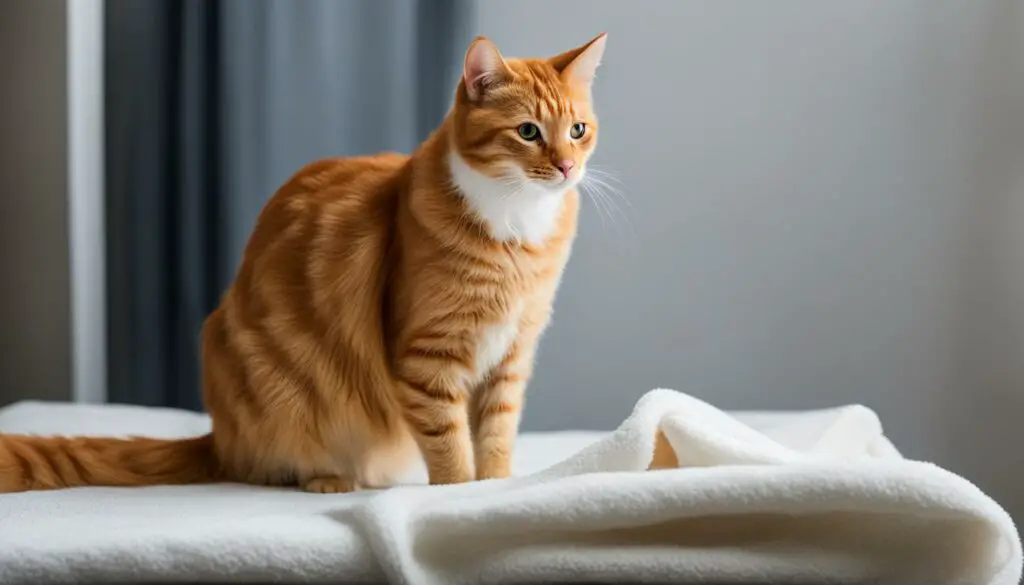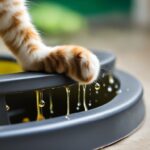Are you dealing with the frustrating behavior of your cat peeing on blankets? It can be puzzling and leave cat owners feeling at a loss for solutions. But fear not, we’re here to help you understand this behavior and explore possible solutions. In this article, we will delve into the reasons why cats engage in this behavior and provide you with valuable insights to address the issue effectively.
Key Takeaways:
- Cats may pee on blankets due to litter box issues, stress, or medical conditions such as urinary tract infections.
- Understanding the underlying cause is crucial in finding a solution.
- Proper litter box maintenance, environmental enrichment, and stress reduction techniques are vital.
- Cleaning and neutralizing cat urine odors can help discourage repeat incidents.
- Consulting with a veterinarian or a veterinary behaviorist can provide expert guidance in dealing with the issue.
Why Do Cats Pee on Beds?
Cats may choose to pee on beds for a variety of reasons. One common factor is litter box problems. Cats are very particular about their litter box preferences and may avoid using it if they find it dirty, uncomfortable, or in an inconvenient location. Additionally, cats may choose to urinate on beds due to stress, marking territory, or as a result of medical issues such as urinary tract infections.
Table: Reasons for Cats Peeing on Beds
| Reasons | Explanation |
|---|---|
| Litter Box Problems | Cats may avoid using the litter box if it is dirty, uncomfortable, or in a inconvenient location |
| Stress | Cats may urinate on beds as a response to stress or anxiety |
| Marking Territory | Cats may pee on beds to mark their territory and establish dominance |
| Medical Issues | Urinary tract infections or other medical conditions may cause cats to urinate on beds |
It is important to address the underlying reasons for this behavior in order to find a solution. By identifying and resolving litter box problems, reducing stress levels, and addressing any potential medical issues, cat owners can help prevent cats from peeing on beds.
Medical Causes of Inappropriate Urination
When it comes to cats peeing on blankets, it’s important to consider the potential medical causes behind this behavior. In some cases, inappropriate urination can be a symptom of an underlying medical condition. Cats with urinary tract infections, kidney disease, or diabetes may exhibit this behavior as a result of their health issues.
A urinary tract infection, for example, can cause discomfort and increased urgency to urinate in cats. This may lead them to choose inappropriate places, such as blankets, to relieve themselves. Similarly, kidney disease and diabetes can affect a cat’s bladder control and result in accidents outside of the litter box.
If you notice your cat peeing on blankets or other household items, it’s essential to consult a veterinarian. They can conduct a thorough examination and run tests to determine if there are any underlying medical conditions contributing to the inappropriate urination. Treating the medical cause is crucial in resolving the behavior and preventing further incidents.
| Medical Conditions | Symptoms |
|---|---|
| Urinary Tract Infection | Frequent urination, straining to urinate, blood in urine |
| Kidney Disease | Increased thirst, decreased appetite, weight loss |
| Diabetes | Excessive drinking, increased urination, weight loss, lethargy |
Behavioral Causes of Inappropriate Urination
In some cases, cats may engage in inappropriate urination behaviors, such as peeing on blankets, due to behavioral issues. Understanding the underlying causes of these behaviors is essential in finding effective solutions. Stress and anxiety are common triggers for cats to urinate outside the litter box, as well as marking territory.
Changes in the household, such as the introduction of new pets or a recent move, can cause stress and anxiety in cats. This can lead to behaviors like urinating on blankets as a way of expressing their distress. Identifying and addressing the source of stress is crucial in preventing further incidents.
| Behavioral Causes | Examples |
|---|---|
| Stress | Recent move, introduction of new pets |
| Anxiety | Loud noises, changes in routine |
| Marking Territory | Showing dominance, claiming ownership |
Proper environmental enrichment can help alleviate stress and anxiety in cats, reducing the likelihood of inappropriate urination. Providing toys, scratching posts, and perches can help keep cats mentally stimulated and engaged. Additionally, creating a calm and predictable environment with consistent routines can help reduce stress levels.
When addressing behavioral causes of inappropriate urination, it may be helpful to consult with a professional, such as a veterinary behaviorist. They can provide guidance on behavior modification techniques, such as positive reinforcement, desensitization, and counter-conditioning, to redirect the cat’s behavior towards appropriate elimination habits.
Litter Box Issues
When it comes to cats peeing on blankets, litter box issues can be a significant contributing factor. Cats are generally clean animals and have specific preferences for their litter box. If these preferences are not met, they may choose to urinate in other areas of the house. Understanding and addressing litter box problems can help prevent inappropriate elimination behaviors.
One common issue is litter box cleanliness. Cats are sensitive to odors and may avoid using a dirty litter box. It’s essential to scoop the litter box daily and regularly replace the litter to ensure cleanliness. Additionally, some cats may prefer a specific type of litter, such as clumping or non-clumping. Experimenting with different litter types can help find the one that your cat prefers.
The placement of the litter box is also crucial. Cats prefer privacy and may avoid using a litter box that is in a high-traffic area or near loud noises. It’s best to place the litter box in a quiet, low-traffic location where the cat feels comfortable and secure. Providing multiple litter boxes in different areas of the house can also help prevent any territorial disputes among multiple cats.
| Litter Box Issues | Solutions |
|---|---|
| Litter box cleanliness | – Scoop the litter box daily – Replace litter regularly – Use enzymatic cleaners to remove odors |
| Litter type | – Experiment with different litter types – Clumping vs. non-clumping – Fine-grained vs. coarse-grained |
| Litter box placement | – Choose a quiet, low-traffic area – Provide multiple litter boxes – Avoid placing near loud noises or high-traffic areas |
By addressing litter box issues, cat owners can create a more suitable and appealing environment for their cats’ elimination needs. This, in turn, can help prevent cats from peeing on blankets or other household items.
Solving Litter Box Issues
In order to address litter box problems and prevent cats from peeing on blankets or other household items, it is important to consider several factors. These include the size, cleanliness, placement, and preferences of the litter box. By addressing these aspects, cat owners can create an environment that encourages appropriate elimination habits.
Size of the Litter Box
The size of the litter box plays a significant role in a cat’s comfort and willingness to use it. It should be spacious enough for the cat to turn around and dig comfortably. Additionally, if there are multiple cats in the household, it is important to provide enough litter boxes to accommodate everyone. The general rule is to have one litter box per cat, plus one extra.
Cleanliness of the Litter Box
Cats are clean animals, and they prefer a clean litter box to do their business. It is essential to scoop the litter box daily and completely change the litter on a regular basis. Failure to maintain cleanliness can lead to a cat avoiding the litter box and seeking alternative places to pee, such as blankets. Using unscented litter is also recommended, as some cats may dislike strong smells.
Placement of the Litter Box
The location and accessibility of the litter box are crucial in encouraging cats to use it. It should be placed in a quiet, private area of the house where the cat feels comfortable and secure. Avoid placing the litter box near loud appliances or in high-traffic areas. Additionally, if the cat has difficulty accessing the litter box, such as due to physical limitations or age, consider using a litter box with low sides or providing steps to make it easier for them.
| Aspect | Recommendation |
|---|---|
| Size of the Litter Box | Spacious enough for the cat to turn around and dig comfortably |
| Cleanliness of the Litter Box | Daily scooping and regular litter changes |
| Placement of the Litter Box | Quiet, private area away from loud appliances and high-traffic areas |
| Preferences of the Litter Box | Experimenting with different litter types and textures to find the cat’s preference |
Preferences of the Litter Box
Each cat has individual preferences when it comes to the type of litter used. Some cats may prefer clumping litter, while others may prefer non-clumping or natural litter options. It is important to experiment and observe the cat’s behavior to determine their preference. Providing a litter box with the cat’s preferred litter type can help encourage them to use it and prevent inappropriate elimination.
By addressing the size, cleanliness, placement, and preferences of the litter box, cat owners can solve litter box issues and reduce the chances of their cats peeing on blankets. Creating a suitable environment for cats to eliminate in can help maintain a harmonious relationship between cats and their owners.

Cat Peeing on Blankets: Environmental Enrichment and Reducing Stress
When it comes to addressing the issue of cats peeing on blankets, it’s essential to focus on environmental enrichment and stress reduction techniques. By creating a stimulating and calming environment for our feline friends, we can help prevent unwanted urination behaviors. Cats are highly sensitive to their surroundings, and ensuring their physical and mental well-being is crucial in promoting appropriate elimination habits and reducing stress.
Environmental Enrichment
Environmental enrichment plays a significant role in keeping cats engaged and content. Providing a variety of interactive toys, scratching posts, and perches can help alleviate boredom and encourage natural behaviors. Cats need mental stimulation and physical exertion, and by offering a range of activities and play options, we can help reduce stress and prevent them from seeking alternative locations to urinate.
Table: Environmental Enrichment Ideas for Cats
| Enrichment Activity | Description |
|---|---|
| Puzzle Feeders | Affixing a portion of their daily food to engaging food puzzles can mentally stimulate cats and provide a challenge during mealtime. |
| Window Perches | Placing perches near windows allows cats to observe the outside world, stimulating their natural instincts and providing entertainment. |
| Hiding Places | Creating cozy hiding spots, such as covered beds or boxes, gives cats a secure space to retreat to when they feel stressed or overwhelmed. |
| Vertical Space | Installing cat trees or shelves provides cats with elevated spaces to climb, jump, and survey their surroundings, giving them a sense of security and territory. |
Reducing Stress
Stress can often be a contributing factor to cats peeing on blankets. It is important to identify potential stressors in their environment and take steps to minimize or eliminate them. Consistency and routine play a crucial role in reducing stress, so maintaining a predictable schedule for feeding, playtime, and litter box cleaning can provide a sense of security for our feline companions.
Quote: “Creating a calm and predictable environment for the cat, with consistent routines and limited exposure to triggering factors, can also reduce stress levels and prevent unwanted behaviors.”
In addition to establishing a consistent routine, it’s important to provide cats with safe spaces where they can retreat and relax. This could include designated hiding spots, quiet areas free from loud noises or sudden movements, and sufficient vertical spaces for them to escape to when they need some solitude.
- Minimize household changes: Cats are sensitive to change, so keeping their environment stable and avoiding major disruptions, such as moving furniture or introducing new pets, can help reduce their stress levels.
- Calming pheromones: Consider using synthetic pheromone diffusers or sprays that mimic the scent of a mother cat to promote a sense of comfort and security in the home environment.
- Positive reinforcement: Rewarding desired behaviors, such as using the litter box, with treats or praise can help create a positive association and reduce stress-related urination issues.
By focusing on environmental enrichment and stress reduction techniques, we can create a harmonious and stress-free environment for our beloved cats. Remember, patience and consistency are key when implementing these strategies, so be sure to give your feline companions the time and support they need to adjust and thrive.

Cleaning and Neutralizing Odors
Dealing with cat urine smells and stains is a top priority for cat owners facing inappropriate urination issues. Properly cleaning and neutralizing cat urine odors not only helps eliminate the smell but also prevents cats from returning to the same spot to urinate. Here are some effective methods and products to tackle cat urine odors:
Enzymatic Cleaners
Enzymatic cleaners are specifically designed to break down the proteins in cat urine, effectively eliminating both the odor and stains. These cleaners work by digesting the organic matter, eliminating the odor at its source. When using enzymatic cleaners, it is important to thoroughly saturate the affected area and allow the product to air dry.
Deterrents
In addition to cleaning, using deterrents can help discourage cats from urinating in unwanted areas. Citrus scents, such as orange or lemon, can be effective in deterring cats as they dislike the strong smell. Aluminum foil can also be used as a barrier on surfaces that cats tend to urinate on, as they dislike the texture and sound it creates.
| Product | Description |
|---|---|
| Enzymatic Cleaner | An enzymatic cleaner specially formulated to break down cat urine proteins and eliminate odors and stains. |
| Citrus Spray | A citrus-scented spray that deters cats from urinating in specific areas. |
| Aluminum Foil | Aluminum foil used as a deterrent by placing it on surfaces where cats tend to urinate. |
By using enzymatic cleaners and deterrents, you can effectively remove cat urine smells, stains, and discourage future urination in unwanted areas. However, it is important to address the underlying causes of inappropriate urination to fully resolve the issue.

Medical Treatment and Behavior Modification
In cases where medical conditions contribute to inappropriate urination, proper treatment and management are essential. It is important to consult with a veterinarian who can perform a thorough examination and provide appropriate medical interventions. Treatment may involve antibiotics for urinary tract infections, medications for kidney disease or diabetes, or other targeted therapies depending on the underlying condition.
Behavior modification is also important in addressing inappropriate urination. Identifying and addressing any underlying behavioral issues can help prevent further incidents. This may involve working with a veterinary behaviorist who can provide guidance on implementing behavior modification techniques.
| Medical Treatment | Behavior Modification |
|---|---|
| Appropriate medications | Identifying triggers and stressors |
| Regular veterinary check-ups | Creating a calm and predictable environment |
| Monitoring and managing medical conditions | Positive reinforcement training |
Combining medical treatment with behavior modification techniques can provide a comprehensive approach to addressing cat urination issues. It is important to understand that both aspects are interconnected and should be addressed simultaneously for optimal results.
Working closely with a veterinarian and potentially a veterinary behaviorist can help develop a tailored treatment plan that takes into account the cat’s individual needs and circumstances. With the right approach and proper management, cat parents can effectively address and resolve inappropriate urination behaviors.
Cats Peeing on Blankets: Prevention Tips
Preventing cats from urinating on blankets requires a proactive approach that tackles both environmental factors and potential sources of stress. By following a few key steps, you can help maintain a clean and harmonious living space for both you and your feline companion.
Create a Consistent Litter Box Routine
One of the most important aspects of preventing inappropriate urination is ensuring a clean and accessible litter box. Regularly scoop the litter box and replace the litter as needed. Cats are clean animals and may avoid using a dirty litter box. Additionally, provide multiple litter boxes in different locations to encourage your cat to use them consistently. Experiment with different litter types to find the one that your cat prefers.
Reduce Stress in Your Cat’s Environment
Stress is a common trigger for cats to urinate outside of their litter box. Minimize stress by creating a calm and predictable environment. Provide your cat with plenty of hiding spots, elevated perches, and interactive toys to keep them mentally stimulated. Avoid sudden changes in routine and introduce new additions, such as other pets or furniture, gradually. If your cat is particularly anxious, consider using pheromone diffusers or supplements to help alleviate their stress.
Consider Consulting a Veterinarian
If your cat continues to urinate on blankets despite implementing preventive measures, it is important to rule out any underlying medical issues. Consult with your veterinarian to ensure your cat is in good health. In some cases, a medical condition, such as a urinary tract infection or kidney disease, could be the cause of the inappropriate urination. Treating the underlying issue will help resolve the problem and prevent further episodes.
| Prevention Tips | Benefits |
|---|---|
| Maintain a clean and accessible litter box | Encourages proper elimination habits |
| Reduce stress in the cat’s environment | Minimizes triggers for inappropriate urination |
| Consult with a veterinarian | Rules out any underlying medical conditions |
By implementing these Prevention Tips and taking a proactive approach to your cat’s well-being, you can help prevent the frustrating behavior of cats peeing on blankets. Remember that each cat is unique, and it may take some time and patience to find the most effective strategies for your furry friend. With consistent effort and a supportive environment, you can create a happy and healthy living space for you and your cat.
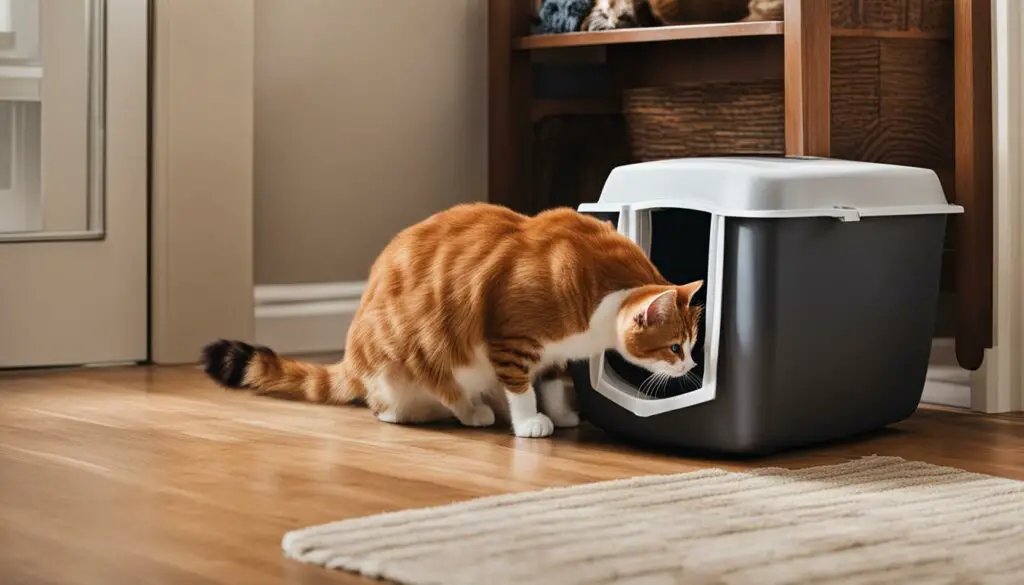
Cat Peeing on Blankets: Dealing with Kittens
If you have a kitten that is peeing on blankets, it can be frustrating and concerning. However, it is important to understand that this behavior is not uncommon in young cats. Kittens are still learning proper litter box habits and may have accidents while they are in the process of being trained. To address this issue, it is crucial to focus on proper litter box training and provide a suitable environment for your kitten.
Litter box training for kittens:
To start litter box training, make sure you have multiple litter boxes available in accessible locations throughout your home. This will ensure that your kitten always has easy access to a litter box when they need to eliminate. Additionally, choose a litter that is suitable for kittens and keep the litter boxes clean and odor-free. Kittens are more likely to use a clean box that is inviting to them.
When your kitten has an accident outside the litter box, do not punish them. Instead, gently redirect them to the litter box and praise them when they use it successfully. Positive reinforcement is key in training your kitten to use the litter box consistently.
| Key Points for Litter Box Training |
|---|
| Provide multiple litter boxes in accessible locations |
| Choose a litter suitable for kittens |
| Keep litter boxes clean and odor-free |
| Redirect your kitten to the litter box when accidents occur |
| Reinforce positive behavior with praise |
Remember, patience is key when it comes to litter box training kittens. It may take some time for them to fully grasp the concept and develop consistent habits. By providing the right environment and consistent training, you can help your kitten learn to use the litter box properly and prevent accidents on blankets or other inappropriate places.
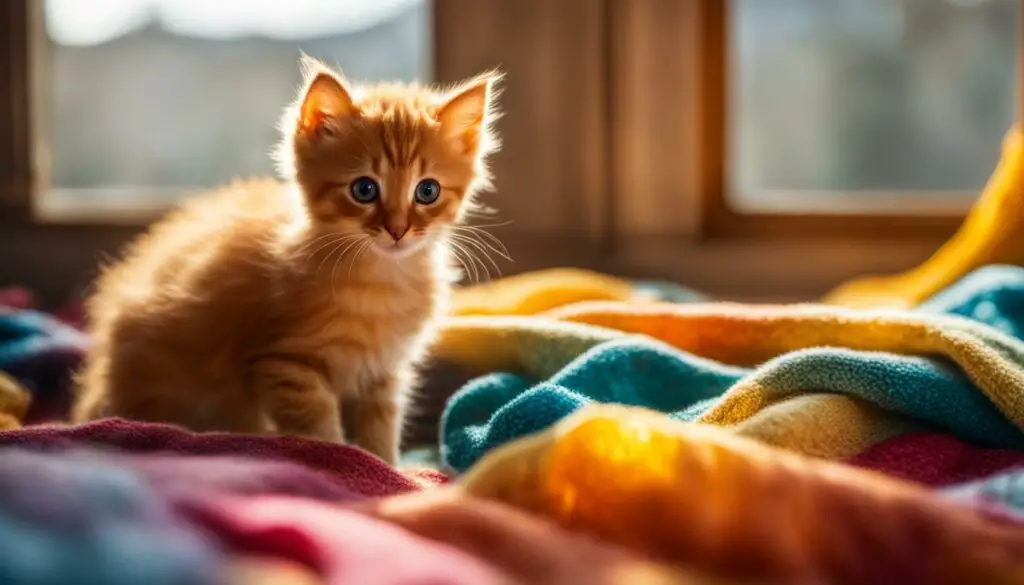
Cat Peeing on Bed: Causes and Solutions
If your cat is peeing on your bed, it can be a frustrating and unpleasant experience. Understanding the reasons behind this behavior is essential in finding a solution to this problem. Several factors can contribute to a cat choosing to urinate on a bed, including stress, territorial marking, or litter box issues.
Common Reasons for Cat Peeing on Bed
- Stress: Cats may urinate on beds as a response to stressful situations, such as changes in the household, new pets, or shifts in their routine.
- Territorial Marking: Cats have scent glands on their paws, and by urinating on the bed, they can leave their scent and mark their territory.
- Litter Box Problems: Cats are meticulous about their litter box preferences. If the litter box is dirty, uncomfortable, or in an inconvenient location, they may choose to urinate elsewhere, such as on the bed.
In order to address the issue of cat peeing on the bed, it is important to identify and address the underlying cause. Here are some potential solutions:
- Provide a Stress-Free Environment: Creating a calm and predictable environment for your cat can help reduce anxiety and prevent inappropriate urination. Try to minimize changes, provide plenty of environmental enrichment, and establish a routine.
- Address Litter Box Issues: Ensure that the litter box is clean, accessible, and in a quiet area. Experiment with different types of litter and litter box designs to find what your cat prefers.
- Use Positive Reinforcement: Reward your cat for using the litter box appropriately. You can praise them, give them treats, or play with them after they’ve finished using the litter box.
- Consult a Veterinarian: If the behavior persists or if you suspect a medical issue, it is important to consult a veterinarian. They can rule out any underlying medical conditions that may be causing the behavior and recommend appropriate treatment.
Remember, cats peeing on the bed is a solvable problem. With patience, understanding, and a proactive approach, you can successfully address this behavior and create a harmonious environment for both you and your furry friend.
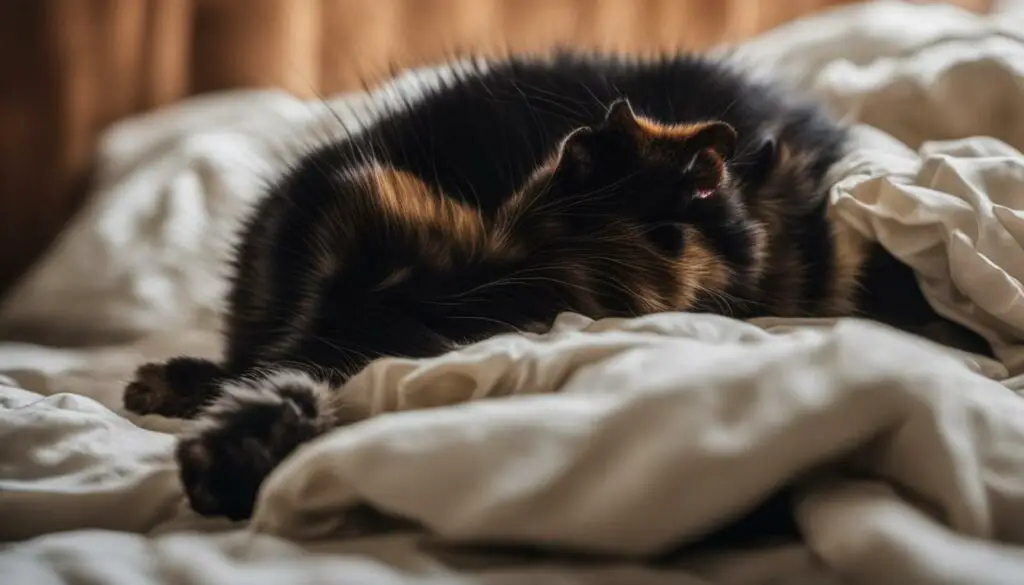
Behavioral Modification Techniques
When it comes to addressing inappropriate urination in cats, behavioral modification techniques can be highly effective. These techniques focus on redirecting a cat’s behavior and encouraging appropriate elimination habits. Positive reinforcement, desensitization, and counter-conditioning are some of the key strategies used in behavioral modification.
Positive Reinforcement
Positive reinforcement involves rewarding desired behaviors to encourage their repetition. When it comes to litter box usage, this can be done by providing treats or praise immediately after the cat successfully eliminates in the litter box. By associating the litter box with a positive experience, the cat is more likely to continue using it.
Desensitization
Desensitization involves gradually exposing the cat to the triggers that may contribute to their inappropriate urination behavior. For example, if the cat becomes anxious or stressed when using a particular litter box location, the owner can gradually introduce the cat to that location in a controlled and calm manner. This process helps the cat become less reactive to the trigger over time.
Counter-Conditioning
Counter-conditioning involves changing the cat’s emotional response to the trigger that causes inappropriate urination. For instance, if the cat associates using the litter box with a negative experience, such as pain from a urinary tract infection, counter-conditioning can be used to create positive associations. This can be achieved by providing treats, playtime, or comfort near the litter box, helping the cat form positive associations with the litter box and reducing any negative emotions.
It’s important to note that behavioral modification techniques require patience and consistency. Each cat is unique, and what works for one may not work for another. Seeking guidance from a professional, such as a veterinarian or veterinary behaviorist, can provide valuable insights and tailored advice for effectively implementing these techniques.
Cleaning and Removing Cat Urine Odor
Dealing with cat urine odor can be a challenge for many cat owners. Whether it’s a lingering smell or unsightly stains, it’s important to tackle the problem head-on. Here are some tips and techniques to help you effectively clean and remove cat urine odor from your home.
Understanding the Importance of Proper Cleaning
Cat urine contains strong-smelling ammonia compounds that can persist even after the urine has dried. Simply wiping away the stain or using regular household cleaning products may not be enough to completely eliminate the odor. To effectively remove cat urine odor, it’s crucial to use enzymatic cleaners specifically designed for this purpose. These cleaners break down the odor-causing compounds at a molecular level, ensuring thorough odor removal.
Steps for Removing Cat Urine Odor and Stains
- Start by blotting up as much urine as possible using paper towels or clean cloth. Avoid rubbing the stain, as it can spread the urine and make it more difficult to remove.
- Apply an enzymatic cleaner to the affected area, following the product’s instructions. Make sure to saturate the area thoroughly to allow the enzymes to penetrate deep into the fabric or surface.
- Let the enzymatic cleaner sit for the recommended amount of time to allow it to break down the odor-causing compounds. This typically ranges from 10 minutes to a few hours, depending on the product.
- After the allotted time, blot up any excess cleaner with clean paper towels or cloth. Avoid rinsing the area with water, as it can dilute the enzymatic cleaner and lessen its effectiveness.
- Allow the area to air dry completely. You may need to repeat the cleaning process for stubborn stains or strong odors.
Using Cat Urine Odor Neutralizers and Deterrents
In addition to enzymatic cleaners, you can also use cat urine odor neutralizers to further combat the smell. These products work by chemically altering the odor molecules, making them less detectable to the human nose. Spraying or applying these neutralizers to the affected area can help mask any residual scent and discourage your cat from urinating in the same spot again.
It’s important to note that deterrents alone may not solve the underlying issue causing your cat to urinate outside the litter box. Identifying and addressing any potential stressors or litter box problems is essential in preventing future accidents.
| Cleaning Tips | Deterrents |
|---|---|
| Use enzymatic cleaners to break down odor-causing compounds. | Try using cat urine odor neutralizers to mask the smell. |
| Blot up as much urine as possible before cleaning. | Use deterrents in areas where your cat tends to urinate. |
| Avoid rubbing or scrubbing the stain, as it can spread the urine. | Consult with a veterinarian if your cat continues to have urination issues. |
By following these cleaning and odor removal techniques, you can effectively eliminate cat urine odor and prevent future accidents. Remember to address any underlying issues that may be contributing to your cat’s inappropriate urination behavior. With patience and perseverance, you can create a clean and odor-free environment for both you and your feline companion.
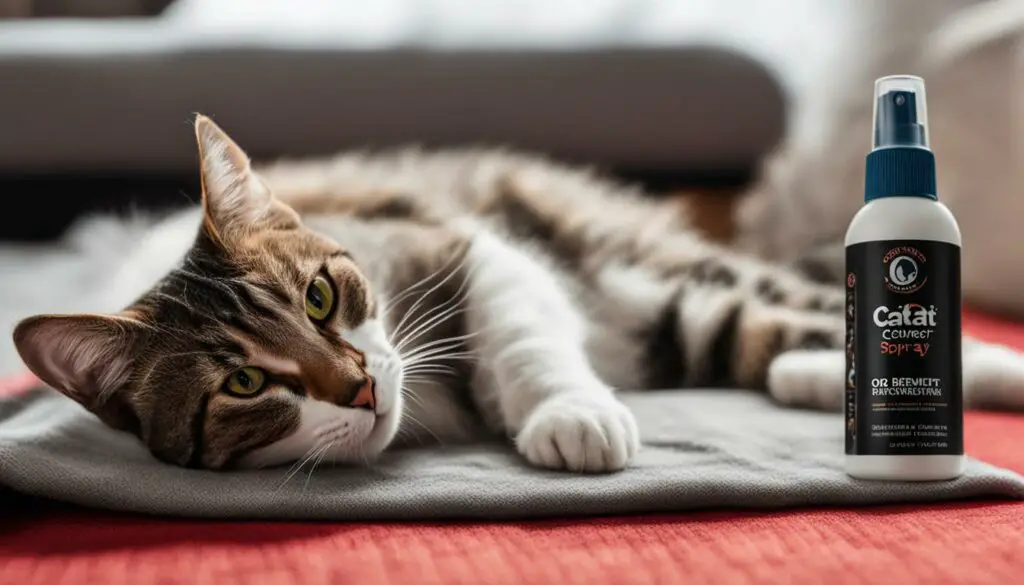
Understanding Cat Behavior and Communication
Understanding cat behavior and communication is crucial for cat owners to effectively address and prevent inappropriate urination. Cats have unique behaviors and ways of communicating, and by gaining insight into their psychology, we can become better cat parents. From their litter box preferences to their body language, learning about cat behavior allows us to create a cat-friendly environment and nurture a strong bond with our feline companions.
The Importance of Cat Behavior
Understanding cat behavior is key to identifying the underlying causes of inappropriate urination. Cats are highly sensitive animals and can exhibit stress or anxiety through behaviors such as urinating outside the litter box. By observing their body language, vocalizations, and habits, we can gain valuable insights into their emotional well-being and provide the necessary support and interventions.
For example, if a cat is consistently eliminating on blankets, it may indicate a litter box aversion or a need to mark territory. By recognizing these behaviors and addressing the root causes, we can enhance their overall quality of life and prevent future incidents.
Interpreting Cat Body Language
Cats communicate through subtle body language cues. Learning to interpret these signals can deepen our understanding of their needs and emotions. Tail position, ear position, and vocalizations are just a few examples of how cats express themselves. Tail held high with a slight curve generally indicates a content and friendly cat, while a tail held low or tucked between the legs may indicate fear or anxiety. Ears pointing forward typically show interest, while flattened ears can signify aggression or fear. By observing and responding to these cues, we can better meet our cats’ needs and provide them with a sense of security.
Creating a Cat-Friendly Environment
Providing a cat-friendly environment is essential for preventing inappropriate urination. This includes offering multiple litter boxes placed in quiet and accessible areas, using cat-friendly litter that the cat prefers, and ensuring regular cleanliness. Additionally, providing enriching activities such as interactive toys, scratching posts, and perches can help stimulate cats mentally and physically, reducing stress and preventing unwanted behaviors.
Understanding cat behavior and communication is an ongoing process that strengthens the bond between cat and owner. By being attentive to their needs and providing a nurturing environment, we can help our cats thrive and eliminate the frustration of inappropriate urination.
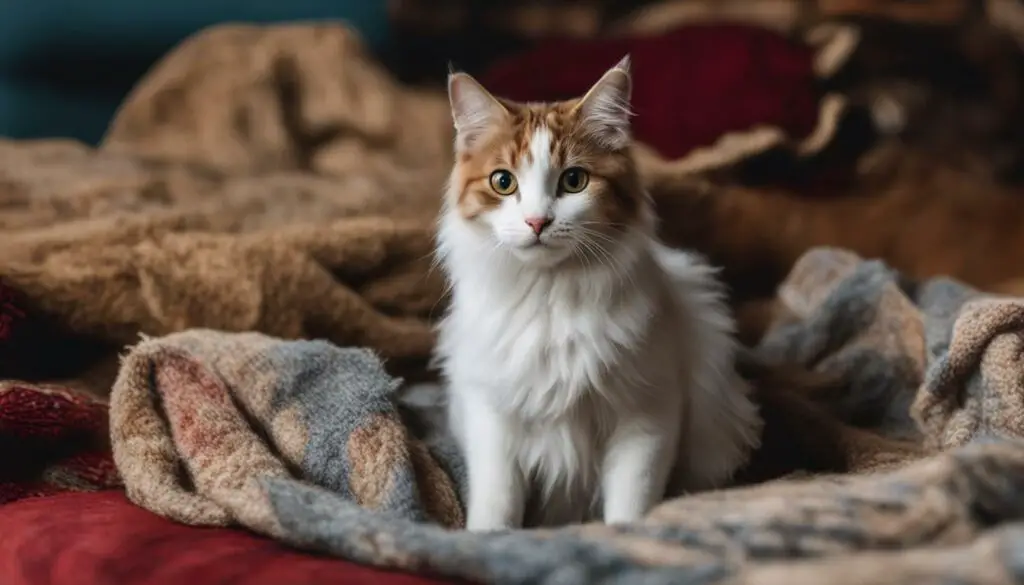
Conclusion
Understanding the reasons behind a cat’s inappropriate urination, such as peeing on blankets, is crucial in finding effective solutions. It is essential to address both medical and behavioral factors that may contribute to this behavior. Consulting a veterinarian to rule out any underlying medical conditions, such as urinary tract infections or kidney disease, is important.
In addition to medical treatment, addressing behavioral causes, such as stress and anxiety, is vital. Providing a stress-free environment, with environmental enrichment and consistent routines, can help reduce the likelihood of cats urinating outside the litter box. Proper litter box maintenance, including cleanliness and suitable placement, is also essential to encourage proper elimination habits.
When dealing with cat urine odors, thorough cleaning using enzymatic cleaners designed for removing cat urine is recommended. These cleaners effectively eliminate both stains and odors, preventing cats from returning to the same spot. Using odor neutralizers and deterrents, such as citric scents or aluminum foil, can also help discourage cats from urinating in unwanted areas.
Overall, by understanding cat behavior and communication, cat owners can establish a harmonious relationship with their feline companions. Providing a suitable environment, addressing medical and behavioral issues, and seeking professional guidance when necessary, can help prevent and manage inappropriate urination, ensuring a clean and comfortable home for both cats and their owners.
FAQ
Why do cats pee on beds?
Cats may choose to urinate on beds for various reasons, including litter box problems, stress, marking territory, or medical issues.
What are some common medical causes of inappropriate urination in cats?
Medical conditions such as urinary tract infections, kidney disease, and diabetes can contribute to cats peeing on blankets or other household items.
What are some behavioral causes of inappropriate urination in cats?
Cats may urinate outside the litter box due to stress, anxiety, or a need to mark their territory.
How can litter box issues contribute to cats peeing on blankets?
Cats may avoid their litter box if it is dirty, has an unpleasant odor, or if they do not like the type of litter used. Additionally, the location and accessibility of the litter box can play a role.
How can I address litter box problems to prevent cat peeing on blankets?
Ensuring the litter box is the appropriate size, providing clean litter, and placing it in a quiet, private area can help encourage cats to use it. Experimenting with different types of litter may also be helpful.
What can I do to reduce stress and anxiety in cats to prevent inappropriate urination?
Providing environmental enrichment, creating a calm and predictable environment, and maintaining consistent routines can help reduce stress levels in cats.
How can I effectively clean and neutralize cat urine odors?
Using enzymatic cleaners designed for removing cat urine can help eliminate smells and stains. Using deterrents such as citrus scents or aluminum foil in problem areas can also be effective.
What are some medical treatments and behavior modification techniques for addressing cat urination issues?
Depending on the underlying cause, medical treatments and behavior modification techniques can be recommended. Working with a veterinarian or veterinary behaviorist can help develop a comprehensive treatment plan.
How can I prevent cats from peeing on blankets in the future?
Regularly cleaning and maintaining the litter box, providing a stress-free environment, and addressing any changes promptly can help prevent future incidents.
How do I deal with kittens peeing on blankets?
Proper litter box training using positive reinforcement techniques, providing multiple accessible litter boxes, and ensuring cleanliness can help kittens develop appropriate elimination habits.
What are some solutions for cats peeing on beds?
Behavioral modification techniques such as positive reinforcement, desensitization, and counter-conditioning can be effective in redirecting a cat’s behavior. Consulting with a professional, such as a veterinary behaviorist, can provide guidance.
How can I clean and remove cat urine odor?
Using enzymatic cleaners designed for cat urine, odor neutralizers, and deterrents can help eliminate odors. Proper cleaning and stain removal are essential to prevent cats from returning to the same spot.
Why is understanding cat behavior and communication important in addressing inappropriate urination?
By understanding their behavior and providing a suitable environment, cat owners can effectively manage and prevent issues related to inappropriate urination.

